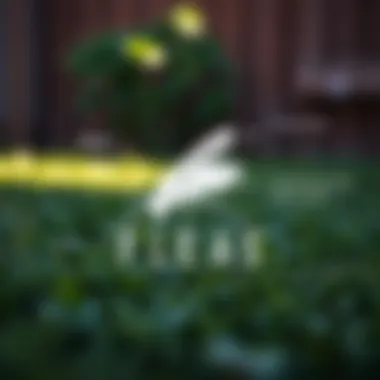Effective Strategies to Eliminate Fleas in Your Yard


Intro
Fleas aren't just a nuisance for our furry friends; they can also turn a well-kept yard into a veritable nightmare. Imagine relaxing outside on a warm afternoon only to have these pesky critters jump onto your clothes or, worse yet, onto your beloved pet. Understanding how to effectively combat flea infestations while keeping your outdoor haven pleasant is key. This guide takes you through essential steps to identify pests, adopt preventive measures, and explore treatment options, ensuring a flea-free yard.
Pest Identification
Identifying fleas and their telltale signs is the first step towards reclaiming your yard. Fleas are tiny, wingless insects, generally measuring about 1/12 to 1/6 of an inch in length. They are dark brown, sometimes appearing almost black, making them pretty hard to spot against the dirt or grass. Their flat bodies allow them to navigate through fur easily, making it hard to detect their presence on pets.
Detailed Descriptions of Common Pests
When we think of yard pests that drive us up the wall, fleas often take center stage. Particularly, the common cat flea, Ctenocephalides felis, is responsible for the majority of flea problems in residential settings. Other notable mentions include the dog flea and various species of biting lice. Often, these critters are more than just an irritant; they can carry diseases and cause severe discomfort.
Signs and Symptoms of Infestations
A few signs can quickly alert you to a flea infestation. Keep an eye out for:
- Frequent scratching or biting: If your pets seem awfully restless, it may not just be a case of having the jitters.
- Flea dirt: This looks like small black specks sprinkled on your pet or yard, a sure sign there’s trouble brewing. Known scientifically as flea feces, these tiny particles are digested blood that fleas excrete.
- Red spots on skin: You might also notice red welts or bites on your pets or yourself.
- Increased fleas: If you see adult fleas jumping on your pets or if you spot larvae or pupae in your yard, you’re in deep trouble.
Recognizing these signs promptly can save you a lot of trouble down the road.
Prevention Strategies
Taking proactive measures is the best way to keep fleas at bay. Prevention is often easier than a full-on battle against an established infestation.
Home Maintenance Tips for Pest Prevention
A well-maintained yard goes a long way in deterring fleas. Here are a few strategies to incorporate:
- Regular Mowing: Keeping your grass neatly trimmed reduces places where fleas can hide and breed.
- Debris Removal: Remove piles of leaves, grass clippings, or anything that can provide shelter for fleas.
- Pet Care: Regularly groom your pets to catch fleas before they set up shop in their fur.
Natural Deterrents and Barriers
There are various natural products you can employ to ward off fleas. Consider:
- Diatomaceous Earth: This natural powder, made from fossilized algae, is effective in desiccating fleas.
- Essential Oils: Oils from lavender, cedarwood, and peppermint can repel fleas. A diluted solution in a spray bottle can refresh your space and keep those unwanted visitors at bay.
Treatment Options
If prevention isn’t enough and a flea invasion occurs, knowing your treatment options is essential. There are two primary methods to consider: chemical and natural treatments.
Overview of Chemical vs. Natural Treatments
Chemical treatments often work quickly but may come with potential side effects for your pets and plants. Natural treatments may take longer to act but can pose fewer risks to the environment.
Step-by-step Guides for DIY Treatments
Here’s a streamlined method you can follow using both approaches:
Chemical Treatment Method:
- Choose a viable spray: Look for a product specifically made for yard use, like Ortho Bug-B-Gon or Raid Yard Guard.
- Application: Spray your yard evenly, focusing on shady areas as fleas prefer these spots.
- Follow-up: Repeat every 7-14 days as directed until the infestation is cleared.
Natural Treatment Method:
- Prepare a mixture: Combine equal parts water and vinegar with a few drops of essential oil of your choice.
- Spray: Apply your mix generously in your yard, especially areas frequented by your pets.
- Maintenance: Reapply after rain or every couple of weeks to maintain effectiveness.
Regular maintenance is the key to a long-term solution. Don’t just treat once and forget.
By following this guide, you’re now equipped with the knowledge needed to create an environment that's welcoming for you and your family but uninviting for fleas. Keeping your yard in top shape is not just about aesthetics; it’s about ensuring a healthy, safe space for everyone.
Prologue to Fleas and Their Impact
Fleas might be tiny, but their impact can feel like a giant problem, especially for pet owners and those who enjoy spending time outdoors. Understanding this pest not only helps with treatment but equips home dwellers with the wisdom to prevent future run-ins. This segment will explore the world of fleas, their biology, and the consequences they bring to our pets and homes. The stakes are high, as the presence of fleas often leads to discomfort and health issues for our beloved animals, and in some cases, even the humans that share their space.
Understanding Flea Biology
To tackle fleas effectively, it's imperative to comprehend their life cycle. Fleas reproduce at an astonishing rate. A female flea can lay up to 30 eggs per day, quickly leading to a population explosion if left unchecked. The eggs, which are tiny and nearly invisible, can fall off pets and hatch in carpet fibers, soil, or wherever pets roam. Understanding that fleas go through four stages—egg, larva, pupa, and adult—can help you identify their presence and development.


- Eggs: Hatch within a week, depending on environmental conditions.
- Larvae: Feed on organic debris and are sensitive to light. They prefer dark locations.
- Pupae: Can remain in a cocoon for several months, waiting for the right conditions to emerge as adults.
- Adults: Start feeding within hours of emergence, seeking out hosts for their blood meal.
Knowing this cycle is essential. It informs when and how often to treat your yard and home, as products need time to disrupt this cycle effectively.
The Detrimental Effects of Fleas on Pets and Humans
The troubles caused by fleas extend beyond simple annoyance; they can lead to significant health impacts for pets and humans alike. Fleas are known carriers of tapeworms and can transmit diseases. For pets, the itchiness commonly results in scratching, which can lead to skin infections. In severe cases, fleas can cause anemia—especially in young or elderly pets, whose immune systems are weaker.
On the human side, flea bites can cause itchy welts, leading to discomfort and irritation. Some people even suffer allergic reactions. Moreover, an infestation poses a considerable nuisance, disrupting day-to-day life.
"Fleas don’t just bite; they invade our lives, turning our peaceful yards into battlegrounds where every day is a fight against the itch."
After uncovering the deep-rooted issues fleas can trigger, it's clear why understanding their biology and effects is imperative. Providing knowledge forms the first line of defense in controlling and eliminating these pestering intruders from your yard.
Why Yard Spraying is Necessary
Understanding the specific need for yard spraying opens the door to more effective flea control. Fleas are quite crafty and can turn any outdoor space into a breeding ground, leading to infestations that find their way into homes. Without addressing the source, which is often found in yards, fleas can become relentless nuisances.
The Flea Life Cycle
Fleas undergo a distinct life cycle that consists of four stages: egg, larva, pupa, and adult. This cycle can be completed in as little as two weeks under optimal conditions, which creates a pressing need for yard spraying. Here are the key points regarding the life cycle:
- Eggs: Fleas lay hundreds of eggs, often in pet bedding or carpets; however, when pets roam outside, they may drop eggs in grassy areas.
- Larvae: The larvae develop in dark and humid areas, feasting on organic debris such as flea dirt. They are barely visible and can blend easily into the environment.
- Pupae: This stage is a protective cocoon, making them immune to so many standard pest control methods.
- Adults: Adult fleas jump onto hosts, leading to more eggs. They can survive for several months without eating!
If you neglect your yard, you’re essentially rolling out the welcome mat for these pests every time your pet steps outside.
Efficacy of Yard Treatments Compared to Indoor Solutions
When it comes to flea infestations, many homeowners often rush to remedies inside the house, maybe thinking the issue is confined there. However, addressing the yard can be just as—if not more—important. Here’s why:
- Targeting the Source: Treating the yard can eliminate fleas at their origin. You'll be thwarting future generations before they have a chance to invade your home.
- Long-Lasting Protection: Yard sprays often provide a prolonged effectiveness compared to indoor solutions, which might need more frequent reapplication due to environmental conditions.
- Prevention of Spread: If fleas are thriving outdoors, they can easily hitch a ride back inside on pets or shoes. By applying treatments outside, you're reducing the risk of an indoor invasion.
In comparison to indoor-only treatments, yard spraying acts in a more holistic manner, addressing both current and potential future infestations:
- 👁️🗨️ Treating indoors alone often leads to a cycle of recurrent infestations. You kill the adults, yet the countless eggs and larvae outdoors remain unchecked.
- 🌱 A yard treatment creates a barrier, reducing the risk of adult fleas migrating in, thus providing peace of mind.
In summary, yard spraying is a crucial step in achieving and maintaining a flea-free environment. By understanding the life cycle and strategizing treatments effectively, homeowners can safeguard their living spaces from these bothersome pests.
Chemical Solutions for Flea Control
When it comes to managing flea populations in your yard, chemical solutions offer potent and immediate results. This section will explore various insecticides that effectively target fleas, ensuring you have the tools you need to reclaim your outdoor spaces. While natural remedies have their place, the reliability and speed of chemical treatments can be crucial, especially in severe infestations.
Understanding Chemical Insecticides
Chemical insecticides are substances designed to kill or repel pests, including fleas. These products disrupt the flea life cycle and can eliminate adult fleas, larvae, and eggs. The importance of understanding these solutions lies in their proper application and potential impact on your yard ecosystem. Using the right insecticides can drastically reduce flea populations while minimizing harm to beneficial insects and plants.
Recommended Chemical Sprays
Several chemical sprays are favored for their effectiveness against fleas. Here are the three main categories:
Pyrethroids
Pyrethroids are synthetic chemicals modeled after pyrethrins, which are derived from chrysanthemum flowers. They are widely recognized for their fast-acting abilities, disrupting the nervous system of fleas upon contact.
- Key Characteristics: Pyrethroids are highly effective against adult fleas but can also impact larvae. They are known for their quick knockdown effect, meaning fleas don’t stand a chance once they come into contact.
- Benefits: The ability to kill fleas almost immediately makes pyrethroids a popular choice for homeowners. Additionally, they have a relatively low toxicity profile for humans and pets when used correctly.
- Disadvantages: While they are effective, pyrethroids can break down quickly in sunlight and may need reapplication more frequently in sunny locations.
Neonicotinoids
Neonicotinoids represent another class of chemical insecticides that target the nervous system of insects. They differ from traditional insecticides by more selectively affecting insects rather than other animals, making them a favorite among some pest control experts.
- Key Characteristics: These compounds mimic nicotine and are highly effective against many pest species, including fleas.
- Benefits: Neonicotinoids like imidacloprid offer long-lasting protection, often preventing flea re-infestations. They work effectively in various environments, being suited for indoor and outdoor use.
- Disadvantages: Some environmental concerns cloud the use of neonicotinoids, particularly regarding their impact on pollinators. Awareness and careful application are critical to mitigate any potential harm.
Growth Regulators
Growth regulators do not kill fleas directly; rather, they disrupt their development cycle. By interfering with the normal growth processes of fleas, these products prevent larvae from maturing into adult fleas.
- Key Characteristics: These insect growth regulators target larval stages, making them a vital part of a comprehensive flea control strategy.
- Benefits: By disrupting the life cycle, growth regulators can significantly reduce flea populations over time. They are often used in tandem with other insecticides for an effective one-two punch against fleas.
- Disadvantages: They may not provide immediate results like contact insecticides. Users should combine their application with other methods to see swift action against existing adult fleas.
Safety Guidelines for Chemical Use


Before applying any chemical product, it’s essential to follow safety guidelines to protect yourself, your pets, and the environment. Always wear protective gear, such as gloves and masks, during application. Ensure pets and people are out of the area while the chemicals dry completely. Also, consider reading the pesticide label thoroughly to understand the correct application rate, timing, and any precautions required for safe use. Remember, a responsible approach to using chemical solutions ensures you achieve effective flea control without risking harm to your household.
"Pest management is not just about killing pests—it's about managing the environment in which they thrive."
For additional resources on flea control, you may visit EPA Flea Control or CDC Flea Information.
As you navigate the options of chemical flea solutions, keep in mind that effectiveness comes with responsibility. A balanced approach, incorporating safety and efficacy, is key to creating a truly flea-free yard.
Natural Alternatives for Flea Management
Natural alternatives for flea management have gained traction among those looking to reduce reliance on chemical treatments. This section is crucial because it gives readers insights into eco-friendly and often safer methods to deal with flea infestations in their yards. Emphasizing natural solutions typically leans towards plant-derived ingredients, which can serve dual purposes—repelling fleas while also being gentle on the environment. Furthermore, the effectiveness of these alternatives is often coupled with the added benefit of fewer health risks to pets and humans.
Essential Oils as Natural Repellents
Lavender Oil
Lavender oil is often hailed for its calming aroma, but its utility extends far beyond relaxation. When it comes to flea control, lavender oil serves as a natural repellent. One key characteristic of lavender oil is its strong scent, which is unpleasant to fleas. This characteristic makes it a beneficial choice for homeowners wanting to keep these pests at bay. A unique aspect of lavender oil is its dual-purpose nature; it not only repels fleas but may also help soothe bites, easing any irritation left behind by these pests. However, it's important to use this oil judiciously, as some pets may have sensitivities.
Peppermint Oil
Peppermint oil is another potent ally in the fight against fleas. This oil packs a punch with its invigorating scent, which fleas and other pests find off-putting. One of its main advantages is the speed at which it works; it can deter fleas almost immediately upon application. Moreover, peppermint oil is also useful in addressing other pests, thereby providing broader protection for your yard. However, the strong menthol aroma might not be appealing to everyone, and some pets can have what seems like a mild aversion to it.
Eucalyptus Oil
Eucalyptus oil stands out for its robust properties. This oil is often utilized for its strong scent, which is highly effective at repelling fleas and other insects. The key attribute of eucalyptus oil is its long-lasting effect, which makes it a beloved choice among many seeking a more resilient natural option. Its pungent odor carries weight in its effectiveness against a broader range of pests. On the downside, eucalyptus oil should be used considerately—some sensitive individuals or pets may experience irritation.
Homemade Flea Sprays
Creating homemade flea sprays can be an art form unto itself, allowing individuals to tailor the mixture to their specific needs. Generally, these sprays often combine the aforementioned essential oils with water or vinegar, providing an easy DIY solution. The advantage of making your own flea spray lies within the ability to control ingredient quality, ensuring a non-toxic approach. However, the effectiveness may vary, and they often require more frequent application compared to commercially prepared solutions.
Benefits and Limitations of Natural Treatments
Natural treatments offer a serene approach to flea management, boasting benefits that include environmental friendliness, safety for pets and children, and often lower costs compared to chemical alternatives. However, these methods come with their drawbacks, such as sometimes being less effective than chemical solutions and possibly requiring more consistent application for ongoing protection. Moreover, certain natural treatments may not provide immediate results, thus demanding patience and diligence from the homeowner.
Optimal Timing for Application
Knowing the right time to tackle flea problems in your yard can be a game changer. Timing can make all the difference, ensuring that your efforts are not just effective but also long-lasting. If you spray when the fleas are most active, you'll get much better results.
Understanding Flea Activity Patterns
Fleas thrive in warm, humid conditions. Their life cycle involves several stages: egg, larva, pupa, and adult. Each stage has its preferred environment, and understanding these can help you greatly in your battle against this pesky parasite.
- Eggs are laid in the environment, often on pets or in bedding, and hatch in about one to four weeks, depending on temperature and humidity.
- Larvae prefer dark, moist areas and feed on organic matter like flea feces. They tend to live in shaded areas of the yard—the perfect spots being under decks or shrubs.
- Pupae can remain dormant for quite some time, waiting for the right conditions. They can sense vibrations and body heat, which prompts them to hatch when a host is nearby.
- Adults need blood meals to reproduce, making your pets a target. An adult flea can live up to several months, depending on conditions.
Thus, if you target your application of sprays when adults are on the prowl, you’ll nip the problem in the bud. Knowing the timing of their life cycles can assist in deciding when to take action, aiming for those weeks shortly after their peak activity.
Best Times for Spraying Your Yard
The best times to spray your yard generally align with flea activity. Here are a few tips to guide your schedule:
- Spring and Early Summer: This is prime flea season, especially as temperatures rise. Start your treatments in late spring. That way, your yard is prepared when fleas begin to hatch.
- Early Morning and Late Evening: During the heat of the day, fleas tend to find cooler spots under leaves or in cracks. Applying spray during the cooler parts of the day can be more effective.
- After Rainfall: While it may seem counterintuitive, spraying after a rain can be useful. Fleas tend to be more active after rain as they emerge in search of hosts. However, ensure that the product you use is resistant to wash-off, or plan to reapply after the rain.
- Regular Monitoring: Set a schedule for monitoring your yard, especially during peak flea seasons. Implementing preventative treatments every few weeks can deter fleas from establishing themselves.
Staying on top of these timing tips can help keep your yard flea-free and ensure that your efforts aren't wasted. It's all about being a step ahead, isn't it?
"Timing is everything, especially when it comes to pest control. A well-timed application can save you a world of trouble down the line."
For more information on flea behavior and practical advice, you can check resources from CDC.gov or University of Florida's Entomology Department.
Step-by-Step Application Process
The process of eradicating fleas from your yard is not just a matter of grabbing a spray and dousing your greenery. It demands a well-thought-out plan. This step-by-step application process is integral to ensuring effective flea control and long-term management. A haphazard effort can lead to frustration, especially when the pesky little critters remain undeterred. By following a structured approach, you can maximize your chances of a successful flea-free yard.
Preparing Your Yard for Spraying
Before you even think about reaching for any chemical or natural solution, it's vital to prepare your yard effectively. Start with a thorough cleaning of the area. Clear out any debris such as leaves, sticks, or old mulch which can provide hiding spots for fleas and their larvae. Consider this a spring-cleaning session for your yard.
Next, mow your lawn to a manageable height. Tall grass might look lush and nice, but it can also become a cozy haven for fleas. By keeping the grass trimmed short, you reduce their hiding spots significantly. If you have any outdoor furniture, move it away from the spray area to avoid contaminating it and ensure a more efficient application.


Tip: Make sure to wear protective clothing and gear, such as gloves and a mask, especially if you are using chemical products. Safety first, always!
Mixing and Using Flea Sprays
Once your yard is prepped and primed, it’s time to mix the flea spray according to the manufacturer's instructions. It’s crucial to follow these guidelines with precision—too strong a mix can harm the environment, while too weak a solution might not do the trick.
When applying the flea spray, target shady areas and spots near the base of plants, as these are often flea hangouts. Use a sprayer that allows for even distribution, making sure to cover the entire yard, including fences and any structures where pets or wildlife may find refuge. As tempting as it might be to rush this step, take your time to ensure every nook and cranny is treated.
Post-Spray Care and Monitoring
After spraying, the work isn't over yet. You need to allow the treated areas to dry before letting pets or children venture back. Post-spray monitoring is equally crucial. Keep an eye on any areas where you notice flea activity, especially if you have pets that go in and out of the yard frequently.
Engaging in routine inspections will help you evaluate the effectiveness of your flea control measures. If you notice fleas bouncing around like they own the place, it might be a sign that you need to reapply your treatment earlier than expected. Always stay diligent, as consistency is key to preventing future infestations. Consider setting a schedule to periodically check the yard, maintain cleanliness, and potentially reapply treatments as necessary.
These steps, carefully monitored and repeated when needed, can foster a flea-free haven in your backyard.
Preventative Measures Against Future Infestations
Preventing fleas from invading your yard is crucial for maintaining a comfortable and healthy outdoor space. Infestations can emerge quickly from seemingly innocuous places, and prevention is often more manageable than eradication. Taking proactive measures can save you time, money and hassle in the long run. In this section, we’ll explore methods that help you steer clear of flea problems right from the start.
Maintaining a Healthy Yard Environment
To create a fortress against fleas, start with your yard’s environment. Fleas thrive in moist, shady areas, so your aim should be to make your yard less appealing to these pests. Consider the following practices:
- Mow Regularly: Keep your grass trimmed to between two to three inches in height. Fleas tend to lounge in longer grass, waiting for a host to latch onto.
- Sunlight Exposure: Trim overhanging branches to allow more sunlight to penetrate your yard. Fleas dislike bright spaces, so increasing exposure can help.
- Eliminate Debris: Clean up leaves, clippings, and any other yard debris. Fleas can find hiding spots in piles or tall clumps of grass.
- Create a Barrier: Use gravel or stone paths around play areas or grassy zones to combat flea migration. This can deter fleas from crossing over into spaces you use often.
- Soil Management: Keeping your soil healthy encourages grass growth and makes it less hospitable for fleas. Testing your soil and adding appropriate amendments can achieve this.
Overall, fostering a vibrant, sunlight-rich yard not only benefits your garden but also acts as a deterrent to pests like fleas. It’s a straightforward approach that lays a solid foundation for flea control.
Using Flea Control Products on Pets
Pets are generally the main culprits in bringing fleas into the yard. Therefore, using flea control products on your pets is vital in your prevention strategy. Here’s what to consider:
- Regular Checks: Inspect your pets regularly for signs of fleas. If you spot flea dirt or small bites, act quickly.
- Quality Products: Rely on recommended flea control products, such as topical treatments like Frontline or oral medications like Comfortis. It's essential to choose ones that suit your pet's specific health needs.
- Shampoos and Collars: Utilize flea shampoos or collars that provide extra protection. These can complement other treatments effectively.
- Maintain a Schedule: Stick to a flea prevention schedule. It generally requires monthly treatments during warm months and a little less frequent in the colder months.
- Educate Yourself: Stay informed about new products and approaches for flea control. Sometimes veterinary offices or pet stores can provide insights into the most effective options available.
Fleas can jump from pets to the yard in no time, so keeping your furry friends protected goes a long way. Make it part of your routine to check and treat your pets, ensuring a flea-free environment for all.
Long-term Solutions to Flea Control
When it comes to handling flea infestations, thinking long-term is essential. Fleas are persistent little critters that can turn a peaceful yard into a bustling breeding ground in no time. Therefore, establishing long-lasting solutions can save homeowners time, money, and much frustration. Long-term strategies not only focus on eliminating present fleas but also on preventing future invasions. This section digs into effective maintenance habits and monitoring practices that can help keep your yard proactive against these pests.
Regular Yard Maintenance Strategies
Keeping your yard spick-and-span can do wonders in the battle against fleas. Regular yard maintenance isn't just about aesthetics; it plays a pivotal role in flea control. Here are some practices to consider:
- Mow the Lawn Regularly: Tall grass provides a cozy environment for fleas. Keeping your grass trimmed will reduce the places fleas can hide and multiply.
- Remove Debris and Clutter: Fallen leaves, branches, and other debris create breeding grounds for fleas. Regularly raking and cleaning your yard will minimize hiding spots.
- Maintain a Healthy Lawn: Healthy grass can outcompete weeds and provide a less hospitable environment for fleas. Regularly fertilizing and watering your lawn will promote robust growth.
- Create a Barrier: Installing gravel or mulch barriers around gardens can deter fleas. Fleas prefer moist environments, and these materials can help in reducing moisture levels.
- Consider Your Pet’s Movement: If your pets roam freely outside, be sure to check their favorite hangout spots. Fleas often thrive where pets spend their time. Regularly treating pets with approved flea control products can also aid in the effort.
By embedding these maintenance strategies into your yard care routine, you'll not only enhance the appearance of your outdoor space but also significantly decrease the flea population.
Monitoring and Assessing Effectiveness of Treatments
Once you've implemented various flea control measures, it’s crucial to monitor their effectiveness. Regular assessments will help you gauge whether your strategies are paying off or if adjustments are needed. Here’s how to approach this:
- Conduct Regular Inspections: Routinely check your yard for flea activity. Look for signs such as flea droppings, which look like tiny black specks, and adult fleas themselves.
- Use Flea Traps: Set up flea traps around your yard to measure fleas' presence. These traps can help you determine if the problem persists after treatment.
- Evaluate Pet Health: Keep an eye out for any itching or discomfort in your pets. Fleas often make their presence known through your pets’ behaviors. If they seem increasingly itchy, it may be time to reassess your methods.
- Adapt Based on Findings: If you find that certain methods aren’t working, be open to modifying your approach. Some strategies work better in specific environments, so it may call for a tailored technique.
Remember: Flea control is not a one-time job; it's an ongoing commitment. Keeping tabs and adjusting your strategy will ensure a flea-free yard year after year.
By integrating regular maintenance with careful monitoring, homeowners can establish a solid defense system against these pesky invaders. The key is to remain vigilant and proactive, ensuring your yard remains a safe haven for both humans and pets.
Finale and Final Thoughts
Dealing with fleas in your yard is no small feat, but understanding the effective measures you can take is paramount. As we've explored this topic thoroughly, it's clear how crucial proper flea control strategies are not only for the comfort of your pets but also for your family's overall well-being. Let’s summarize the significant points from the article and consider future approaches to pest management.
Recap of Effective Flea Control Techniques
Throughout this article, we’ve discussed a variety of techniques aimed at eliminating fleas from your yard, ranging from chemical solutions to natural alternatives. Here’s a concise recap:
- Chemical Sprays: Products like Pyrethroids and Neonicotinoids effectively target adult fleas while growth regulators can stymie the reproductive capabilities of these pests. It's crucial to follow safety guidelines when using them to protect both your family and local wildlife.
- Natural Alternatives: Essential oils, such as Lavender, Peppermint, and Eucalyptus, can provide non-toxic options for repelling fleas, appealing to those who prefer eco-friendly solutions. Homemade flea sprays are simple yet effective, combining common household ingredients with natural repellents.
- Optimal Timing and Application: Timing your sprays based on flea activity patterns can enhance efficacy. Spraying during cooler parts of the day or after rain when the environment is more conducive to effectiveness is essential.
- Preventative Measures: Regular maintenance of your yard, including mowing and trimming shrubbery, reduces potential flea habitats. Using flea control products on your pets ensures they are protected from these pests before they return to the yard.
Future Considerations in Pest Management
Flea management is not a one-off task but instead requires attention and adaptation over time. As you move forward, keep these considerations in mind:
- Ongoing Monitoring: Regularly check your yard and pets for signs of flea activity. Keeping an eye out helps you act quickly if fleas start to return.
- Integrated Pest Management (IPM): This approach combines various strategies and practices to control pests with the aim of minimizing risks to people and the environment. Educating yourself on the behaviors and life cycles of fleas can allow for more targeted actions in the future.
- Stay Informed: Knowledge about emerging flea-control technologies and practices is beneficial. Make it a point to read up on the latest research and recommendations published by reliable sources such as the CDC or university extensions.
- Community Engagement: Collaborating with your neighbors can multiply your efforts. Share resources and strategies to tackle flea outbreaks collectively, creating a flea-free environment for everyone.
Effective flea management is an ongoing commitment that demands both diligence and a proactive outlook.



